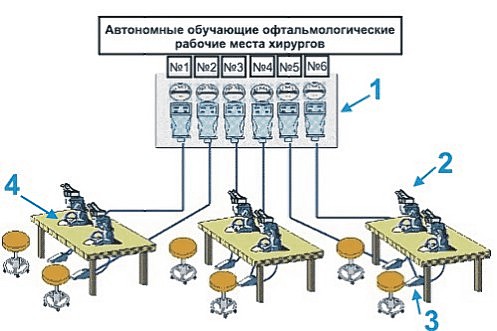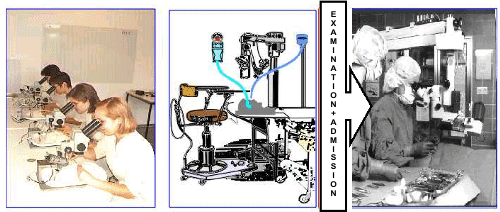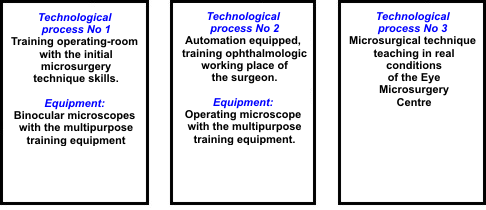Intense training technologies for ophthalmosurgeons
There was and till now remains a problem of qualitative training of experts in the sphere of eye microsurgery. It is not a question of a qualification and professional development of a narrow circle of microsurgeons as it is everywhere in practical public health services, but it is a question of the advanced technologies of teaching of all medical experts without exception from the master, intern up to the professional microsurgeon under a main indispensable condition - to study all the time everything and everywhere. Of course such condition at the extensive method of management is not feasible because of excessively big costs. Therefore it was important to make the intense method, so this happened during training of microsurgeons as the traditional methods of teaching to surgical operative techniques hindered and hinder to master advanced technologies and a surgery as a science.
In general, a training system on models is not new; it is used in Filatov scientific research institute of ophthalmic illnesses, in Academy of further education, however it was not widely adopted in practice in Ukraine. As a lack of innovational didactic technologies hinders from the implementation of advanced, most effective methods of surgical treatment, and therefore their implementation is able to fill in the gap in training of ophthalmosurgeons on scale of the country.
Now in system of further education there is an undesirable, however, prognosticated situation when doctors-interns, especially of surgical specialties, in particular in ophthalmology are in serious difficulty in mastering of surgical skills. With implementation of insurance medicine, the most actual problem will be a risk of postoperative complications, in a case if an unskilled expert, in particular a doctor-intern, is admitted to operation. And implementation of standards, measures of efficiency and quality as the basic components of the insurance medicine, makes participation of an intern in operation undesirable. Fears of a surgeon are quite explainable and clear. How the future surgeons are to be trained if the traditional system of their training excludes interest of such training on the part of practical public health services. And the answer to this question is to be given not by the public health services, but by the other branch of a national economy - the educational system.
A tendency to increase a quality of rendering of surgical assistance has resulted in search of new modern methods of organization of educational process and their optimization.
At the Crimean Republic Center of Vision Rehabilitation it is built a training-experimental operating room, where teaching to primary skills of microsurgical technique on a principle - «from model to human» is carried out.
Basis of technology is:
- Biomodelling of processes:
- Physiology of a healthy eye,
- disease,
- diagnostics
- Training to skills of microsurgical technique with the help of ophthalmosimulators, stands, and multipurpose training-medical lines.
Biomodelling with ophthalmosimulators enables to reproduce a functioning of an organ or system, including, abnormalities, to simulate any complex "extraordinary" clinical case. So, the special engineering equipment enables to imitate such diseases as a pterygium and other pathologies, to implant an intraocular foreign body on an eye of an animal, and then to "cure" it, what makes the basic stage of training of experts.
The training-experimental ophthalmosurgery is represented with two training operating rooms: operating room Nr.1 with 6 seats, presenting I a stage (preparatory) of training to the ophthalmosurgery. There is carried out training to primary skills of microsurgical technique (fig. 1).
 |
Рис. 1.
1 - Гидравлическая ирригационная система, обеспечивающая физиологическое или повышенное внутриглазное давление. Система орошения глаза;
2 - Учебный, хирургический бинокулярный, микроскоп;
3 - Педаль регулировки внутриглазного давления;
4 - Фантом-маска с глазами животного.
|
Each of the seats, equipped with the special binocular microscopes, represents an independent training ophthalmologic work place of the surgeon with a modular principle of organization. Modularity and autonomy enables to replicate in future such training places of low cost in all medical institutions (fig. 2).
A training operating room Nr. 2 provides the second (basic) stage of training. Here skills of operative microsurgical technique on available and developing procedures are worked through. In this operating room operations are carried out with a help of an operative microscope.
Both operating rooms are equipped with a complete set of the training multipurpose equipment: the hydraulic irrigative system providing making of a physiological or increased intraocular pressure, aspirating system, allowing to carry out a dosed aspiration of fluid from an eye, automatic system of an eye irrigation, a phantom - mask with an inserted animal eye, allowing to operate in conditions close to natural, a manometer showing an intraocular pressure, a pedal with the hydraulic valve, allowing to adjust an intraocular pressure. Such complete set allows excluding necessity of the assistant, having made an independent training ophthalmologic work place.
According to the uniform technology the department on storage and preservation of eyes with the special equipment providing maximum safety of all tissues of an eye on the basis of experimental technology is formed: with the help of temperature, chemical and physical bases.
Both in the first and in the second operating rooms operations are carried out with the real surgical instruments and a suture material.
A peculiarity of the training operating rooms is the opportunity of repeated improvement of technological operations of microsurgery, teaching to all surgical methods and approaches used in the ophthalmology, and also new methods of surgical procedures.
The indispensable condition of the innovational pedagogical technology is the exact conformity to uniform standards that can be provided only at the uniform standardized methods of education. This condition caused a necessity of development and implementation of uniform flow charts, some kind of protocols of operations, but distinguished from them with the exact list of operative manipulations consistent and identical in all country. Flow charts are in this case some kind of a standard.
The subsequent examination on the acquirement of skills to surgical technique at the level of required standards will determine the right to move a trainee to the third technological stage - to a clinical ophthalmosurgery, i.e. training on a patient in conditions of the center of an eye microsurgery. Thus the status of a trainee does not matter - a master, intern, resident or practical doctor - a condition of stage-by-stage transition with the subsequent certification is distributed to each of them.
Thus, this training-experimental surgery is a complex three-stage technological process (fig. 3).
Wide implementation of training operating rooms in practical public health services enables a higher school to solve many problems during training of students, which were till now unsolved.
So, the training student's program of a cycle of any surgical specialty includes first of all a superficial acquaintance with operating rooms. Its visit by students results in its dirtying with the subsequent possible complications at the patient. Training operating rooms allows receiving some kind of a compromise - to achieve a desirable training result with no clinical risk.
Applied character of the given technology in teaching of students is dictated by:
- Absence of necessity for attendance by students of a real operating room, but only training-experimental one.
- Opportunity "to try" oneself as a surgeon.
- Acquaintance with surgical equipment.
 |
| ТЕХНОЛОГИЯ ОБУЧЕНИЯ МИКРОХИРУРГИИ ГЛАЗА "КРЫМ·МЕД·ДИДАКТИК"
по системе - от биомодели к человеку -
|
 |
 |
On the whole the intense training technologies in an ophthalmosurgery allow:
- To exclude or reduce need in patients with either, one or another disease during training, especially when contact to him is excluded or extremely restricted.
- To ensure calmness and confidence of a teacher and a trainee during carrying out of operation without any risk to injure a patient;
- To exclude or minimize potential complications in the further practical work of a trainee;
- To improve constantly at mastering of new procedures, operations, technologies;
- To reconstitute the lost skills and abilities of a surgeon;
- To master a work on new technique;
- To exclude the admission to the patient of the untrained expert by preoperative testing;
- To use uniform standards, measures of efficiency and quality of treatment;
- To solve research problems and to conduct scientific - experimental researches;
- To reduce a number of insured accidents and claims;
- To reduce time of an expert training;
- To reduce financial costs of his training;
- To implement an occupational selection of ophthalmosurgeons according to their suitability either, one or another kind of operation.
For the first time in ophthalmologic practice the intense training technologies allowed to put on stream of training to the extremely difficult in diagnostics search, and removal of a foreign body of an eye.
Localization of a foreign body in the eye cavity presents frequently certain difficulties even for the experienced doctor. It is possible to achieve quality and perfection in a search process of a foreign body only having a great clinical experience. If interns or residents still don’t have it, it is very difficult to gain it at the present system of education, since it is almost not possible for a trainee to have an opportunity to make ultrasonic diagnostics by himself, to interpret roentgenograms, to find on a surface of an eyeglobe a place of a forthcoming incision or a trepanation, and moreover to remove a foreign body.
With the purpose of improvement of quality of diagnostics in its localization there are worked out the diagnostic technologies modelling all process: an implantation of a foreign body, diagnostics of its localization and removal from an eye.
The first stage of technology is implantation of a foreign body into an eye, included development and making of procedure of removal of the eye contents with replacement of it by gel. For this purpose gelatinous models of an appropriate consistence were made and a balanced mode was worked out, allowing to make conditions for keeping in the thickness of a gel of a foreign body of a various configuration and properties on the one hand and a possibility for functioning of a removing magnet on the other.
A special instrument enables to implant a foreign body into any set field of an eye. A use at the second stage - diagnostics, of echo biometrics allows to locate a foreign body, and the subsequent radiodiagnosis allows specifying a place of its localization. Removal of a foreign body with the use of a constant magnet finishes all process of training.
A use of echo biometrics allowed comparing characteristics of echo signals to the geometrical dimensions of an artificial foreign body seen through a gelatinous model.
Implantation of a similar foreign body into an eye of an animal inserted into the phantom-mask supplemented the technology with a more real representation of its localization. At the same time pictures of echo signals from various subjects (metal and non-metal) were studied.
A use for these purposes of an artificial skull has largely approached researches to natural conditions. Ultrasonic researches were supplemented with a radiographic one according to the method of Comberg-Baltin. Series of models have been created with the purpose of spatial representation of foreign body localization.
A high comprehensibility of a material is provided due to comparisons of the data of echo biometrics, radiodiagnosis and determination of actual coordinates of the foreign body determined at a incision of an eyeglobe.
The principle of feedback when a trainee, having cut an eyeglobe, determines visually the location of a foreign body, allows to determine at once at what stage of diagnostics the error was made - at echo biometrics or radiodiagnosis if divergence of the received results takes place.
With the purpose of making of the standard conditions, allowing to extrapolate this method to a human it was necessary to create a device, allowing to determine an intraocular pressure in the injured animal eye. For this purpose there was used a method of Macklakov with the modified tonometer weighing 35,5 grams with the ruler of Polak designed for this load and for the dimensions of a pig and a cow eye. Repeatedly reproduced process of an implantation of a foreign body into an eye, its localizations and removal from an eye by each trainee largely reduces a percent of diagnostic and clinical errors in a consequence.
The mentioned method of training also concerns to the category of the most efficient and should be used, both during training of students, and in training of doctors-interns, residents, practical doctors.
As a whole the intense training technologies in an ophthalmosurgery should become in higher schools a priority and as far as possible be extrapolated on the other surgical specialties: vascular surgery, neurosurgery and other surgical disciplines.
[Contents]
|


